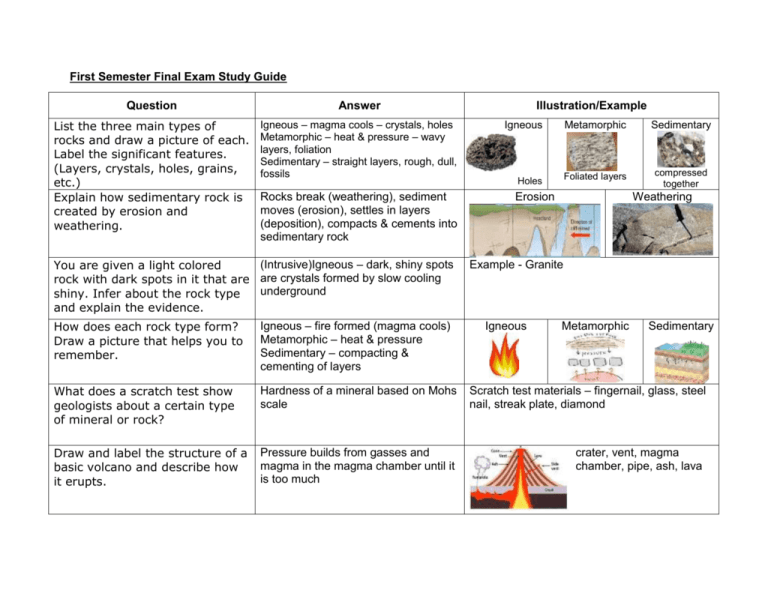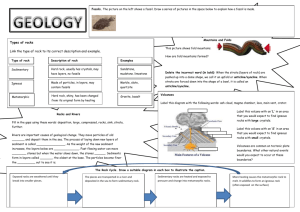1st Semester Study Guide Answer Key
advertisement

First Semester Final Exam Study Guide Question Answer List the three main types of rocks and draw a picture of each. Label the significant features. (Layers, crystals, holes, grains, etc.) Explain how sedimentary rock is created by erosion and weathering. Igneous – magma cools – crystals, holes Metamorphic – heat & pressure – wavy layers, foliation Sedimentary – straight layers, rough, dull, fossils Rocks break (weathering), sediment moves (erosion), settles in layers (deposition), compacts & cements into sedimentary rock (Intrusive)Igneous – dark, shiny spots You are given a light colored rock with dark spots in it that are are crystals formed by slow cooling underground shiny. Infer about the rock type and explain the evidence. How does each rock type form? Draw a picture that helps you to remember. Igneous – fire formed (magma cools) Metamorphic – heat & pressure Sedimentary – compacting & cementing of layers What does a scratch test show geologists about a certain type of mineral or rock? Hardness of a mineral based on Mohs scale Draw and label the structure of a basic volcano and describe how it erupts. Pressure builds from gasses and magma in the magma chamber until it is too much Illustration/Example Igneous Metamorphic Sedimentary Holes Foliated layers compressed together Erosion Weathering Example - Granite Igneous Metamorphic Sedimentary Scratch test materials – fingernail, glass, steel nail, streak plate, diamond crater, vent, magma chamber, pipe, ash, lava Question Answer Illustration/Example What is Mohs’ Scale used to determine? Hardness of a mineral. 1= softest - 10=hardest What rock type is pictured? How do you know? Metamorphic – wavy layers Example – marble, gneiss Explain the difference between weathering and erosion. Weathering – breaks rocks Erosion – moves rocks Weathering What is it called when minerals are moved from one place to another resulting in layers? List the properties that help identify rock types. Deposition Example - beaches Color, luster, texture, grain size, hardness, streak, break Rough smooth Density What are the three volcano types and what are they made of? Cinder – ash Shield – rock Composite – rock & ash Erosion Cinder metallic Cleavage 1-10 Mohs Fracture Break Shield Composite Question Answer Illustration/Example Draw and label the rock cycle and explain how it works. Rocks change by weathering & erosion breaking down, compacting & cementing (sedimentary), heat & pressure (metamorphic), melting & cooling (igneous) Igneous rocks are made from Explain how igneous rocks are created and then changed cooling and hardening of magma – break apart into sedimentary rocks. (weathering) - moves(erosion) deposits in layers – compacts & cements (sedimentary rock) Igneous – formed by magma Which type of rock cannot which destroys fossils have fossils? Why? Use the geologic column below to answer questions 1-4. 1. Which rock layer is the oldest? 1. Layer F 2. Layer B 3. Law of Superposition; intrusion 4. Newer because it is higher up. Too hot – melts fossils Law of Superposition – rock layers at the bottom are the oldest Intrusion – younger than the layer they cross 2. Which rock layer is the newest? 3. How do you know which layers are younger? 4. Is layer C older or newer than layer F? Why? What is a fossil? How are fossils made? Remains of organisms preserved in rock, ice, tar, or amber - Organisms are covered by sediment which replaces Rock Ice Tar Amber Question Answer What are index fossils and how can they be used to date rock layers? Fossils that lived for a short time in many places - Compare to rocks to find age Vibrations created by earthquakes Primary (p) waves, Secondary waves (s), surface waves (most destructive) Explain what seismic waves are, name the three types, and which is the most destructive. What is the evidence for the theory of continental drift? Fossils, continents fit like a puzzle, rock layers matching, glacier grooves, sea-floor spreading Name the three types of plate boundaries, explain their movement, and give one result of each. Divergent – spreading / rift valleys Convergent – collide – volcanoes, trenches Transform – side to side earthquakes What causes an earthquake? Vibrations caused by movement of the lithospheric plates What are mid-ocean ridges and what type of boundary occurs there? Ridges – places where sea-floor spreading is occurring Divergent boundaries Illustration/Example Example - Trilobites (S) waves Divergent (P) waves Surface waves Convergent Transform Question Answer Illustration/Example What is a hot spot? Give two examples of places fueled by hot spots. Mantle plume that creates volcanoes in the middle of plates Island chains, supervolcanoes, etc. Examples – Hawaii, Yellowstone On Mohs’ scale of hardness, what are the softest and hardest minerals? Softest – Talc Hardest- Diamond Talc What is the movement of the plates caused by? After you have completed an experiment and you find that your hypothesis is incorrect, what should be done next? What is the mass Diamond Convection in the mantle. Hot magma rises- cools and sinks moving the plates above Change your hypothesis and test again. 272.1g 200 + 70 + 2.1 = 272.1 *always label with grams (g) measurement for the object on the triple beam balance above? Why are safety rules important in the lab? To keep students and teachers safe Safety First Question Answer When is it okay to begin using materials in the lab? What is a graduated cylinder used to measure and what label should be used for objects that it measures? What is the measurement of the liquid? When given permission by the teacher What is a meniscus? How do you measure using the meniscus? Meniscus- the curve of the water in a graduated cylinder Measure from the bottom of the curve About how old is the earth? What evidence do scientists have to support this? 4.5 - 4.6 billion years old Rocks give the age What are the divisions of geologic time? What happens at the end of each era? Eon, Era, Period, Epoch Eras end in mass extictions Describe intrusive and extrusive igneous rocks and explain the difference between them. Intrusive – form inside the earth Extrusive- form on the earth’s surface GC – measures volume of liquids and irregular objects Label with mL for liquids; cm3 for irregular objects 43 millileters (mL) Illustration/Example “You may begin.” Liquids Irregular objects Check the scale of the GC to be sure it is by 1 Meniscus Rocks give relative age Eras end – extinctions (dinosaurs = end of Mesozoic era) Intrusive Formation Underground Example Granite (crystals) Extrusive Formation Above ground Example Pumice (holes)








